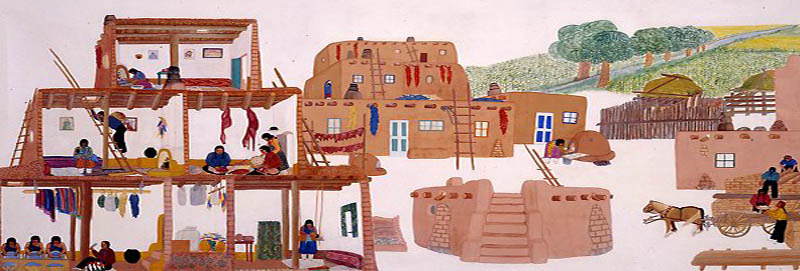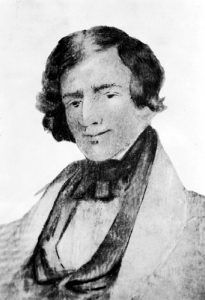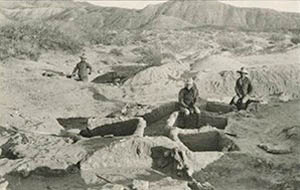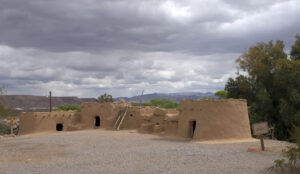Pueblo Grande de Nevada, also known as the “Lost City,” is a complex of villages located near Overton, Nevada.
Founded by Basketmaker people in about 300 A.D., it was later occupied by other groups, including the Ancient Puebloans (Anasazi) until 1150 A.D. Many generations of the Anasazi lived in this area from their archaic and basketmaker beginnings through the Pueblo periods to the eventual abandonment. The site also shows signs of human occupation as early as 8000 BC.
More than 1,000 years ago, Native Americans began migrating to the area that was to become Lake Mead, and a native culture soon developed and flourished in the Moapa Valley of Southern Nevada. This culture’s development paralleled the well-known Puebloan cultures of the Southwest in the Four Corners area of Utah, Colorado, New Mexico, and Arizona. These Native American groups probably shared skills and lifestyles, but they may or may not have shared language and kinship.
The modern Hopi culture in Arizona claims all of these people as their ancestors. In the Hopi language, these “ancient ones” are known as Hisatsinom.
The documented history of the area began in 1827 when explorer Jedediah Smith found various artifacts while traveling through Southern Nevada. The Pueblo Grande complex was first seen by other whites in 1867.
There was little interest in the area until 1924 when brothers John and Fay Perkins, citizens of Overton, Nevada, stumbled across the ruins near the now-submerged town of St. Thomas. When the Perkins heard that Governor James Scrugham was looking for such sites to develop for tourism, they brought this site to the public attention. Mark Raymond Harrington was the first archaeologist to excavate at the site in 1924, by Scrugham’s request. Harrington was later assisted by members of the Civilian Conservation Corps as they rushed to complete excavations that were to be covered by Lake Mead. Excavations began in 1924 and continued off and on until 1938.
Small homesteads were scattered along the northeast edge of the Moapa Valley for about six miles, starting near Logandale and extending southeast into what is now the Overton Arm of Lake Mead. The “Lost City” captured the imagination of Nevada and soon became a tourist spot.
As many as 50-100 people lived there in about 1000 to 1050 A.D. Harrington found 45 homesteads, most of which included “living rooms” with hearths, associated with a line of smaller storerooms. One or two families lived in each home. The structures were built of mud and sandstone, with clay floors. None were more than one story high. these people grew corn, squash, cotton, and beans on the floodplain of the Muddy River and collected other foods, such as mesquite pods and amaranth seed. Most of their meat came from rabbits and desert tortoises. At least 45 people were found buried in the area. Most of them had pottery bowls, jars, or canteens with them, and some also had baskets, cotton cloth wrappings, or turquoise or shell beads.
Early and important archaeological finds were highly publicized and promoted. It was during this period that the somewhat romantic title of “Lost City,” was picked up by the popular press.
The Lost City ruins were just part of the exploration of the area. To the south of Overton Beach are prehistoric salt mines. The early inhabitants of the region mined these salt caves for food preparation and trading. The caves were excavated in about 1925 and items found in the caves included pottery, stone clubs, sandals, and other items.
As the Hoover Dam was nearing completion, it became apparent that the reservoir that would be formed behind the dam would eventually cover the Lost City. The National Park Service, working with the state of Nevada, rushed to recover as much information as possible from the doomed sites. Archaeologists worked up until the last minute, recording information as water began to seep into the site.
In studying the ruins, archaeologists learned that the Puebloans were one in a string of Native American groups living throughout the lower Moapa Valley. Archaeological remains indicated that the first people to live in the area were the Basketmakers, so-named for their intricate and prolific use of basketry. These people constructed their homes underground in the pit-house form. Later the Puebloans introduced adobe above-ground structures. More than just simple one-room houses, these structures of the Lost City were often very elaborate, sometimes consisting of 20 or more rooms with one structure having more than 100 rooms.
Unearthing walls, tools, weapons, food, and skeletal remains provided archaeologists the basis for studying and understanding an important part of Native American history. Eventually, the Pueblo people moved into the area and the two groups lived side by side, often combining their ways of life. Whether by peaceful means or through war, the cause for this melding of cultures is unknown.
Later, the Paiute lived in the area and were the last inhabitants before white settlers came to the region.
Not all sites were drowned by the lake. Luckily, hundreds of sites remained above water and various artifacts were saved from the Lost City to be housed in the Lost City Museum of Archaeology in Overton, Nevada. The museum was built in 1935 by members of the Civilian Conservation Corps.
The National Park Service turned the museum over to the state of Nevada in the mid-1950s. The site was listed on the National Register of Historic Places on October 8, 1982. The museum has grown to include three exhibition galleries, a small screening room, a research library, and a museum store. Outdoor exhibits include a Native American pit house and reconstructed pueblos.
The site comprises the highest concentration of prehistoric Pueblo sites in Nevada.
More Information:
Lost City Museum
721 S Moapa Valley Blvd
Overton, NV 89040
702-397-2193
©Kathy Weiser-Alexander/Legends of America, December 2021.
Also See:
Ancient Cities of Native Americans
Ancient & Modern Pueblos – Oldest Cities in the U.S.
Native American Archaeological Periods
Native Americans – First Owners of America
Native American Photo Galleries
Sources:
Online Nevada
Online Nevada – 2
National Park Service
Wikipedia





